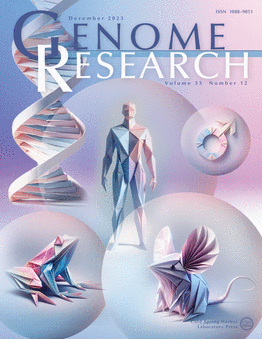Cancer Driver Topologically Associated Domains identify oncogenic and tumor suppressive lncRNAs
IF 6.2
2区 生物学
Q1 BIOCHEMISTRY & MOLECULAR BIOLOGY
引用次数: 0
Abstract
Cancer long noncoding RNAs (lncRNAs) have been identified by experimental and in silico methods. However, current approaches for identifying cancer lncRNAs are not sufficient and effective. To uncover them, we focused on the core cancer driver lncRNAs, which directly interact with cancer driver protein-coding genes (PCGs). We investigated various aspects of cancer lncRNAs, including their expression patterns, genomic locations, and direct interactions with cancer driver PCGs, and developed a pipeline to unearth candidate cancer driver lncRNAs. Finally, we validated the reliability of potential cancer driver lncRNAs through functional analysis of bioinformatics data and CRISPR-Cas9 knockout experiments. We found that cancer lncRNAs were more concentrated in cancer driver topologically associated domains (CDTs), and CDT is an important feature in identifying cancer lncRNAs. Moreover, cancer lncRNAs showed a high tendency to coexpress with and bind to cancer driver PCGs. Utilizing these distinctive characteristics, we developed a pipeline CADTAD to unearth candidate cancer driver lncRNAs in pan-cancer, including 256 oncogenic lncRNAs, 177 tumor suppressive lncRNAs, and 75 dual-function lncRNAs, as well as in three individual cancer types, and validated their cancer-related function. More importantly, the function of 10 putative cancer driver lncRNAs in prostate cancer was subsequently validated to influence cancer phenotype through cell studies. In light of these findings, our study offers a new perspective from the 3D genome to study the roles of lncRNAs in cancer. Furthermore, we provide a valuable set of potential lncRNAs that could deepen our understanding of the oncogenic mechanism of cancer driver lncRNAs.癌症驱动拓扑结构域识别致癌和肿瘤抑制lncrna
肿瘤长链非编码rna (lncRNAs)已经通过实验和计算机方法被鉴定出来。然而,目前鉴定癌症lncrna的方法还不够充分和有效。为了揭示它们,我们专注于核心癌症驱动lncrna,它们直接与癌症驱动蛋白编码基因(PCGs)相互作用。我们研究了癌症lncrna的各个方面,包括它们的表达模式、基因组位置和与癌症驱动PCGs的直接相互作用,并开发了一个管道来发现候选的癌症驱动lncrna。最后,我们通过生物信息学数据的功能分析和CRISPR-Cas9敲除实验验证了潜在癌症驱动lncrna的可靠性。我们发现癌症lncrna更集中在癌症驱动拓扑相关域(cancer driver topological associated domains, CDT), CDT是识别癌症lncrna的一个重要特征。此外,癌症lncrna显示出与癌症驱动PCGs共表达和结合的高度倾向。利用这些独特的特征,我们开发了CADTAD管道来挖掘泛癌症中的候选癌症驱动lncrna,包括256个致癌lncrna, 177个肿瘤抑制lncrna和75个双功能lncrna,以及三种不同的癌症类型,并验证了它们的癌症相关功能。更重要的是,随后通过细胞研究验证了10个假定的癌症驱动lncrna在前列腺癌中的功能,以影响癌症表型。鉴于这些发现,我们的研究为从3D基因组研究lncrna在癌症中的作用提供了一个新的视角。此外,我们提供了一组有价值的潜在lncrna,可以加深我们对癌症驱动lncrna的致癌机制的理解。
本文章由计算机程序翻译,如有差异,请以英文原文为准。
求助全文
约1分钟内获得全文
求助全文
来源期刊

Genome research
生物-生化与分子生物学
CiteScore
12.40
自引率
1.40%
发文量
140
审稿时长
6 months
期刊介绍:
Launched in 1995, Genome Research is an international, continuously published, peer-reviewed journal that focuses on research that provides novel insights into the genome biology of all organisms, including advances in genomic medicine.
Among the topics considered by the journal are genome structure and function, comparative genomics, molecular evolution, genome-scale quantitative and population genetics, proteomics, epigenomics, and systems biology. The journal also features exciting gene discoveries and reports of cutting-edge computational biology and high-throughput methodologies.
New data in these areas are published as research papers, or methods and resource reports that provide novel information on technologies or tools that will be of interest to a broad readership. Complete data sets are presented electronically on the journal''s web site where appropriate. The journal also provides Reviews, Perspectives, and Insight/Outlook articles, which present commentary on the latest advances published both here and elsewhere, placing such progress in its broader biological context.
 求助内容:
求助内容: 应助结果提醒方式:
应助结果提醒方式:


